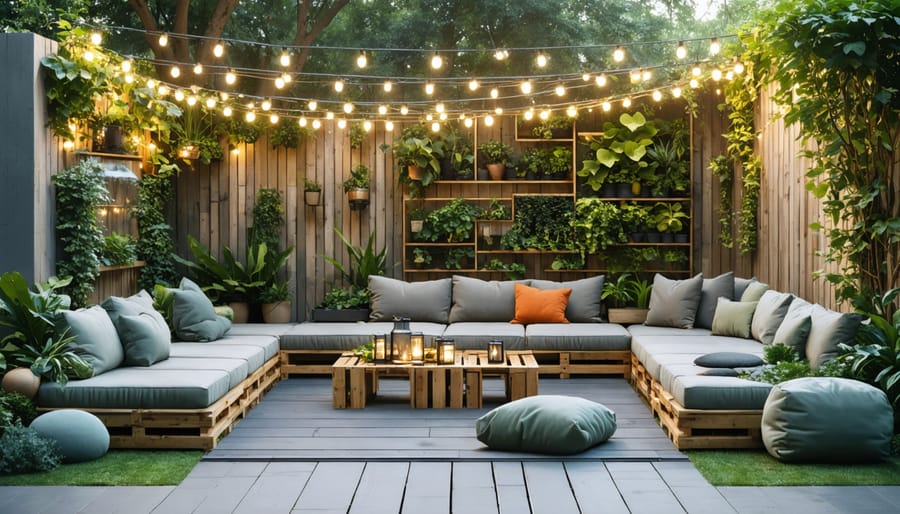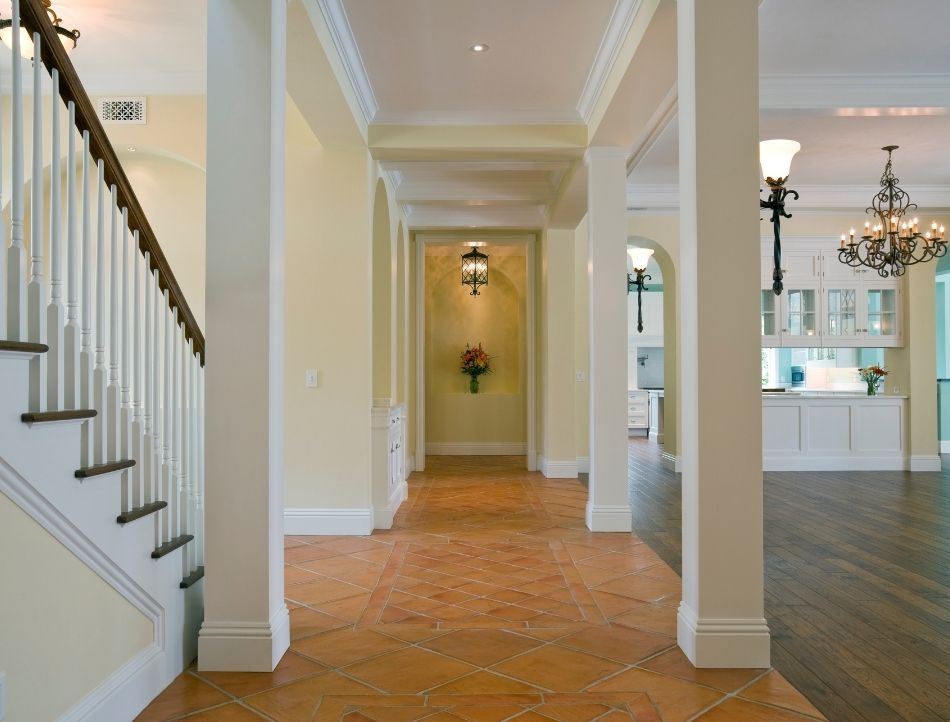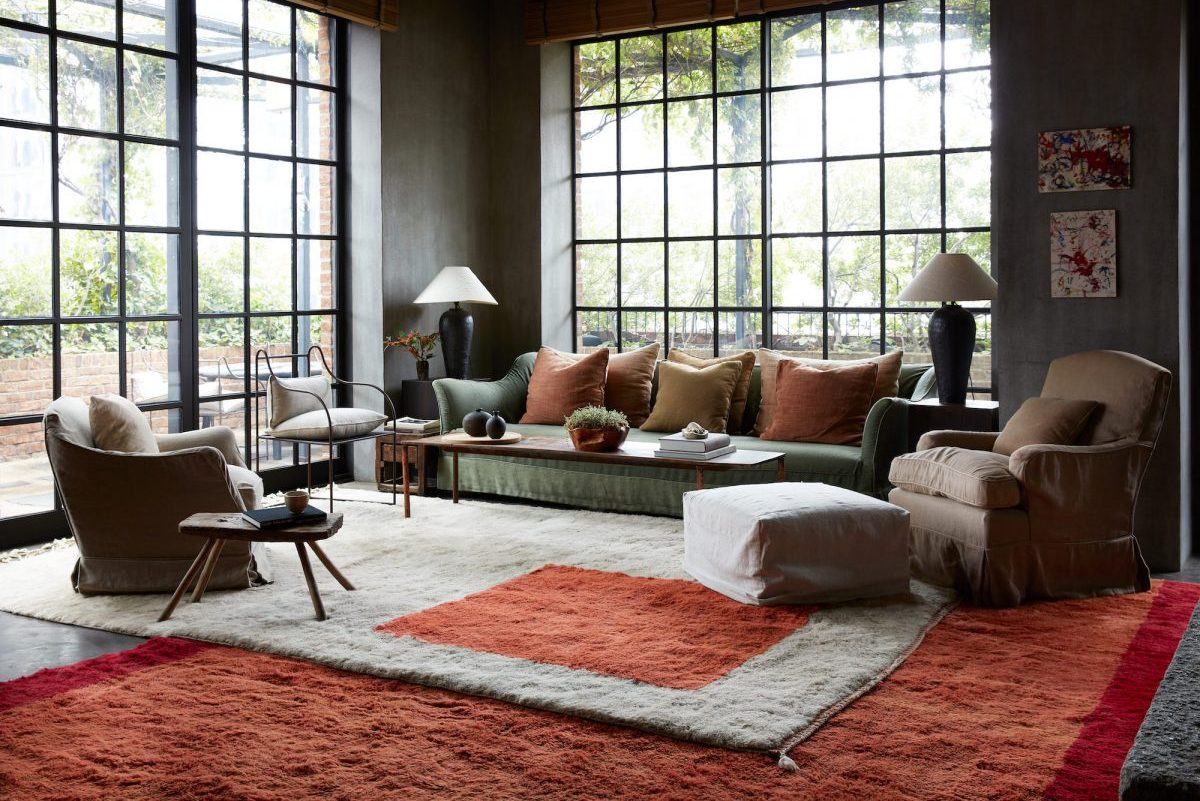Transform your backyard into an outdoor living paradise by creating distinct zones that flow naturally into each other, using sustainable materials like reclaimed wood and native plants to define each space. Install solar-powered lighting along pathways and gathering areas, combining energy efficiency with ambiance through string lights, LED lanterns, and illuminated water features. Build multi-functional spaces that adapt to different activities – think convertible seating areas that transition from casual lounging to outdoor dining, complemented by vertical gardens that provide both privacy and fresh herbs.
Layer your outdoor environment with natural textures and eco-friendly elements: permeable pavers for pathways, living walls for visual interest, and rain gardens that manage water runoff while creating stunning focal points. Incorporate smart technology thoughtfully, using weather-resistant speakers hidden in planters and automated irrigation systems that conserve water while maintaining your green spaces. These sustainable design choices not only reduce environmental impact but create an immersive outdoor experience that seamlessly blends entertainment with ecological responsibility.
Natural Elements That Double as Entertainment Features
Living Walls and Vertical Gardens
Transform your outdoor space into a stunning vertical oasis with living walls and vertical gardens – nature’s answer to sustainable entertainment backdrops. These eye-catching installations not only create a gorgeous focal point but also help purify the air and reduce your carbon footprint.
Start small by installing modular pocket planters on a sunny wall or fence. These flexible systems allow you to experiment with different plant combinations and expand your garden over time. For the best results, choose a mix of trailing plants like pothos or ivy, flowering varieties such as petunias, and structural plants like ferns or small ornamental grasses.
Consider incorporating an irrigation system with a timer to maintain consistent moisture levels. This not only keeps your plants healthy but also reduces maintenance time. A drip system works particularly well for vertical gardens, delivering water directly to plant roots while minimizing waste.
For entertainment spaces, position your living wall where it’ll create maximum impact – perhaps behind an outdoor dining area or adjacent to a lounge space. Add subtle evening lighting to transform your green wall into a magical nighttime feature. Solar-powered LED strips work wonderfully and maintain the eco-friendly theme.
Remember to choose plants suited to your climate and sun exposure. Local native species often thrive with minimal care and provide natural habitat for beneficial insects and birds, adding extra life to your outdoor entertainment area.
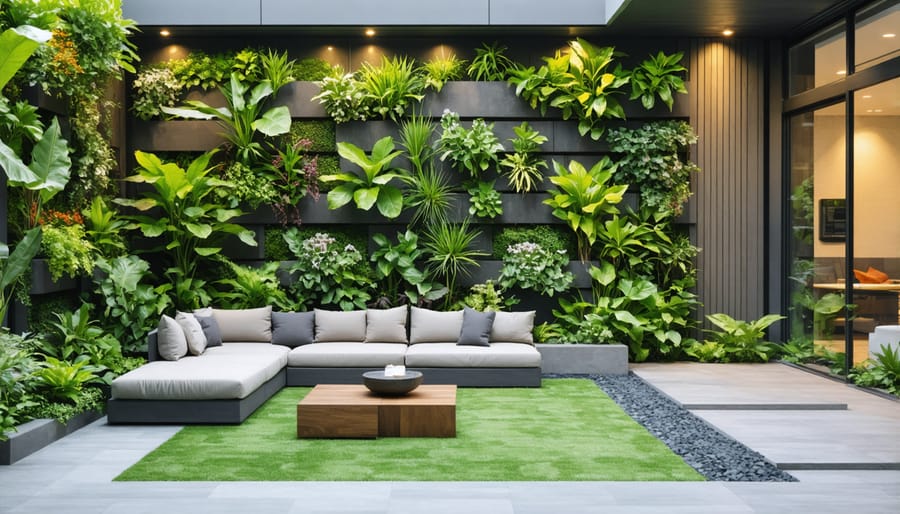
Water Features with Purpose
Water features aren’t just beautiful additions to your outdoor space – they can serve multiple purposes while creating a serene atmosphere. A strategically placed rain garden can collect and filter stormwater runoff, reducing erosion and nurturing native plants. These natural filtration systems add visual interest while supporting local wildlife and helping manage water resources.
Consider installing a recycling fountain that doubles as a natural cooling system. During hot summer days, the flowing water helps lower the surrounding temperature while providing a soothing soundtrack to your outdoor gatherings. For a more practical approach, a decorative rain barrel can be transformed into an artistic focal point while harvesting rainwater for your garden.
Living walls with integrated drip systems offer another innovative solution. These vertical gardens can filter greywater from your home while creating a stunning green backdrop. Add some carefully positioned solar-powered pumps, and you’ve got an energy-efficient system that maintains itself.
For those with limited space, tabletop water features using recirculated water can create ambiance without excessive consumption. Think beyond traditional fountains – consider incorporating a small stream that waters your herb garden or a musical water feature that makes use of recycled materials.
Remember, the key is to choose water elements that complement your lifestyle while supporting environmental sustainability. Whether it’s a small meditation pond or a comprehensive rainwater harvesting system, every drop counts toward creating a more eco-conscious outdoor space.
Sustainable Materials for Outdoor Entertainment Spaces
Reclaimed and Recycled Materials
Creating unique outdoor spaces doesn’t mean you need to buy everything new. In fact, some of the most charming and character-rich outdoor environments incorporate reclaimed and recycled materials. Beyond being eco-friendly, these materials often come with fascinating stories and can save you money while helping you create a truly one-of-a-kind space.
Consider using old wooden pallets, which can be transformed into vertical gardens, rustic seating, or creative wall features. Salvaged brick and stone make excellent pathways or fire pit surrounds, while vintage doors can become striking garden gates or decorative wall pieces. When exploring sustainable furniture options, look for pieces made from reclaimed wood or recycled materials.
Old metal items like wheels, tools, or industrial equipment can serve as unique garden art or functional features. Wine bottles and mason jars make beautiful lighting fixtures or edge borders, while broken ceramic tiles can be reimagined into stunning mosaic tabletops or stepping stones.
Local salvage yards, antique shops, and construction sites (with permission) are excellent sources for these materials. Before using any reclaimed items, ensure they’re properly cleaned and safe for outdoor use. Watch for sharp edges, treat wood for weather resistance, and check that materials aren’t contaminated with harmful substances.
Remember, the key to successfully incorporating recycled materials is balance – mix them thoughtfully with new elements to create a cohesive look that feels intentional rather than haphazard.
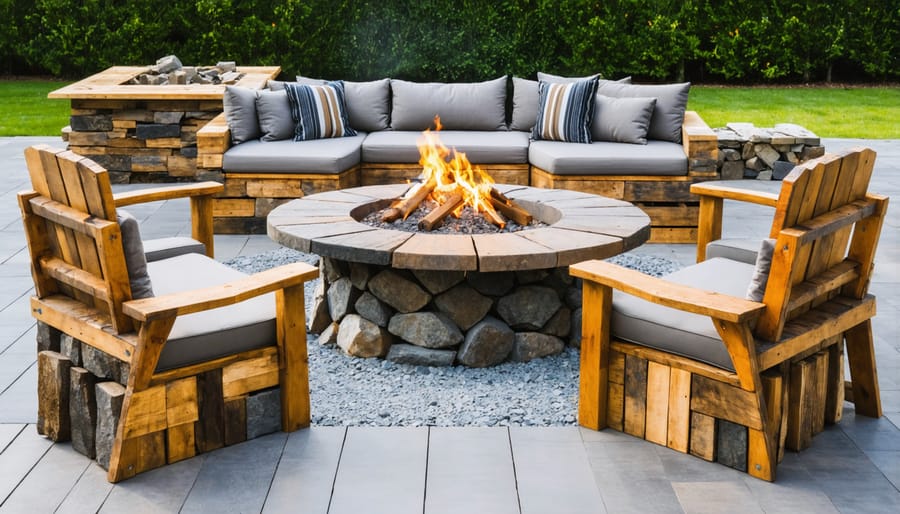
Weather-Resistant Eco-Friendly Furniture
Creating an inviting outdoor space doesn’t mean compromising on environmental values. Today’s eco-conscious outdoor furniture combines durability with sustainability, offering stylish solutions that stand up to nature’s challenges while protecting it.
Reclaimed teak and sustainably harvested bamboo lead the way in weather-resistant natural materials. These materials naturally resist moisture, insects, and UV damage while bringing warmth and character to your outdoor space. For a modern twist, look for furniture made from recycled plastic lumber (RPL) – it mimics the look of wood but requires zero maintenance and can withstand decades of exposure to the elements.
Consider modular pieces crafted from recycled aluminum or stainless steel, finished with non-toxic powder coating. These pieces not only resist rust and fading but can be easily reconfigured for different gatherings. Many manufacturers now offer cushions made from recycled marine plastic with weather-resistant, solution-dyed fabrics that maintain their color even in harsh sunlight.
For budget-friendly options, explore furniture made from repurposed pallets or salvaged materials. With proper sealing and weather-resistant finishes, these pieces can be both eco-friendly and durable. Add weather-resistant hemp or recycled polyester throws and pillows for comfort and style.
Remember to look for furniture with replaceable parts – this extends the life of your pieces and reduces waste. Store cushions in a weather-resistant storage box when not in use, and consider furniture covers for extreme weather protection.
Smart Energy Solutions for Outdoor Spaces
Solar-Powered Lighting Systems
Illuminate your outdoor spaces sustainably with solar-powered lighting systems that transform your backyard into an entertainment paradise after sunset. These eco-friendly lighting solutions not only reduce your energy bills but also add a magical ambiance to your outdoor living areas.
Start by installing solar path lights along walkways and garden borders for safety and visual appeal. These lights charge during the day and automatically illuminate as darkness falls, requiring zero maintenance beyond occasional cleaning. For entertaining areas, consider solar-powered string lights draped across pergolas or between trees – they create a warm, inviting atmosphere perfect for evening gatherings.
Security doesn’t have to compromise style. Motion-activated solar flood lights can be strategically placed near entrances and dark corners, providing peace of mind while maintaining your outdoor aesthetic. For a touch of whimsy, try solar-powered garden stakes with color-changing LED features, or floating pool lights that create stunning water reflections.
Remember to position solar panels where they’ll receive maximum sunlight during the day. South-facing installations typically work best in the Northern hemisphere. For year-round reliability, opt for high-quality panels with weather-resistant materials and long-lasting batteries. Many modern solar lights now come with smart features, allowing you to control brightness and timing through your smartphone.
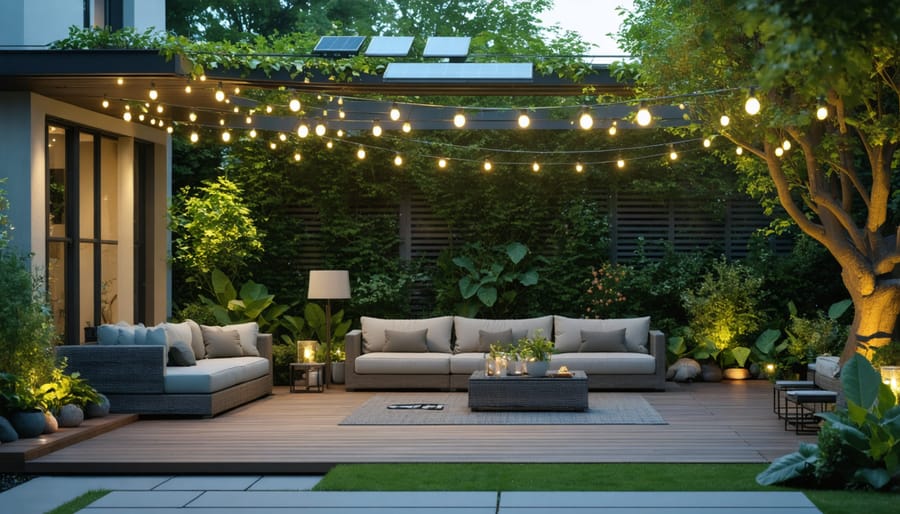
Wind and Solar Entertainment Features
Harness the power of nature to keep your outdoor entertainment going with sustainable energy solutions. Solar-powered LED string lights create a magical ambiance while consuming zero grid electricity, perfect for illuminating evening gatherings. Consider installing solar panels on your pergola or shed roof to power outdoor speakers, charging stations, or even a small outdoor refrigerator.
Wind-powered features add both functionality and visual interest to your space. Small vertical wind turbines can generate supplemental power for your outdoor electronics while serving as conversation-starting artistic elements. Combined with solar, these wind turbines create a reliable hybrid power system for your outdoor entertainment needs.
Make the most of these renewable solutions with smart placement. Position solar panels where they’ll receive maximum sunlight exposure, typically facing south in the Northern Hemisphere. For wind features, observe your yard’s natural air patterns to identify the best spots for turbines. Many modern solar and wind products come with battery storage systems, ensuring you have power even when conditions aren’t optimal.
Don’t forget the smaller touches – solar-powered pathway lights, wind-activated garden ornaments, and battery-free weather stations can add charm while demonstrating your commitment to sustainable living. These eco-friendly additions not only reduce your carbon footprint but can also lead to significant savings on your outdoor entertainment energy costs over time.
Low-Maintenance Design Strategies
Native Plant Selection
Embracing native plants in your outdoor space isn’t just environmentally friendly – it’s a smart design choice that can save you time and money. These botanical superstars are already perfectly adapted to your local climate, which means they’ll naturally thrive with minimal maintenance and watering.
Start by researching plants indigenous to your region through your local extension office or native plant society. Look for varieties that offer year-round interest through seasonal changes. Consider combining flowering perennials like coneflowers and black-eyed susans with ornamental grasses for texture and movement. Native shrubs and small trees can provide structure while supporting local wildlife.
Layer your plant selections by height, with taller species at the back and shorter ones in front. This creates visual depth while ensuring each plant gets adequate sunlight. Don’t forget to group plants with similar water needs together for efficient irrigation.
Remember that native plants often take a season or two to establish themselves, but once they do, they’ll reward you with lasting beauty and resilience. They’ll also attract beneficial insects, birds, and butterflies, turning your outdoor space into a vibrant ecosystem that’s both beautiful and sustainable.
Smart Space Planning
Smart space planning is all about making the most of every square foot while minimizing your environmental footprint. Start by creating distinct zones for different activities – dining, lounging, and entertainment – while maintaining natural flow between areas. Consider multi-functional furniture pieces, like storage benches or convertible tables, to maximize utility without cluttering the space.
Vertical gardening is a game-changer for smaller areas. Install living walls or tiered planters to grow herbs and vegetables without taking up valuable floor space. Position seating areas to take advantage of natural shade from trees or structures, reducing the need for artificial cooling solutions.
When planning pathways, use permeable materials like gravel or spaced pavers to allow water absorption and prevent runoff. Incorporate built-in seating along walls or fences to eliminate the need for additional furniture while creating cozy conversation nooks.
Think about seasonal usage too. Design covered areas that protect from both sun and rain, and plan spaces that can adapt from summer entertaining to cozy fall gatherings. Remember to leave open areas for natural grass or ground cover – these spaces help with temperature regulation and provide essential drainage.
By thoughtfully planning your outdoor space, you’ll create an environment that’s both functional and environmentally conscious, making the most of every inch while minimizing resource consumption.
Creating a sustainable outdoor living space isn’t just about enhancing your home’s appeal – it’s about fostering a deeper connection with nature while being mindful of our environmental impact. Throughout this guide, we’ve explored various ways to transform your outdoor areas into vibrant, eco-friendly spaces that serve both entertainment and environmental purposes.
Remember that sustainable outdoor living is a journey, not a destination. Start small with native plant selections and water-efficient features, then gradually incorporate more elements like solar lighting, recycled materials, and rainwater harvesting systems. These thoughtful choices not only reduce your ecological footprint but often lead to lower maintenance costs and increased property value.
The key to success lies in finding the right balance between functionality and sustainability. Whether you’ve created a cozy reading nook under a living pergola, installed a water-smart garden, or built an outdoor kitchen using reclaimed materials, each element should reflect your personal style while supporting environmental stewardship.
As you move forward with your outdoor projects, consider how each addition impacts both your lifestyle and the ecosystem. Choose materials wisely, embrace local biodiversity, and create spaces that encourage outdoor gathering and connection with nature. By making conscious decisions in our outdoor environments, we’re not just creating beautiful spaces – we’re contributing to a more sustainable future for generations to come.

